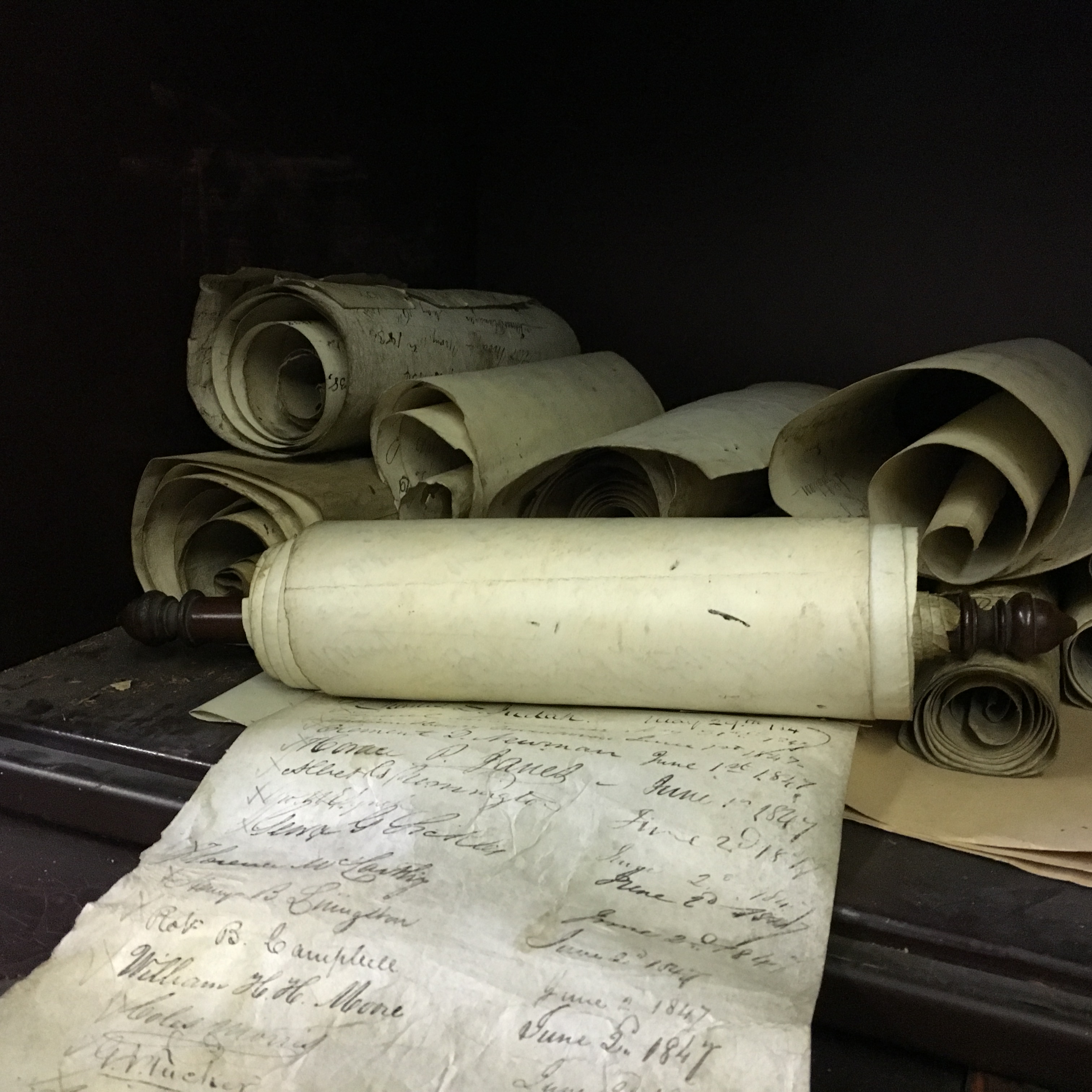This article was written by Dr. James D. Folts, head of Researcher Services at the New York State Archives.
Photo: Supreme Court of Judicature roll of attorneys admitted to practice. [NYSA series JN541]
Parchment was used for the rolls of attorneys admitted to practice in the Supreme Court of Judicature. This long roll, comprised of parchment sheets sewn together and wound on a wooden dowel, shows the names and dates of attorneys admitted in 1847.
Court Records as Sources for History
Archival records of New York’s Unified Court System contain unique, valuable information about court operations and caseloads, trends in civil litigation and criminal prosecution, changes in civil and criminal procedure, the decisions of judges, the practices of trial attorneys, the rights and status of persons, and the overall impact of the courts on New York’s society since the seventeenth century. These records often provide the only documentation of ordinary people, including those who were marginalized, especially in the colonial and early national periods.
Many historical records of New York’s courts have been lost over time. An important success in preserving a major collection of those that survive occurred in early 2017, when nearly 2,000 cubic feet of records of the Supreme Court of Judicature and the Court of Chancery were transferred from the New York County Clerk’s Office to the New York State Archives in Albany (read Geof Huth’s part 1 & part 2 of his account of the transfer of documents – Geof is the Chief Records Officer and Chief Law Librarian of the New York State Unified Court System). These records joined nearly 5,000 cubic feet of records from upstate court offices that were transferred to the State Archives in 1982, thereby creating a complete, statewide resource of historical court records dating from 1683 to 1847.
Records of the Supreme Court and Chancery Court
The Supreme Court of Judicature was established in 1691 as a court of general common-law jurisdiction and continued with minimal change under the first State Constitution of 1777. The Court of Chancery, formed in 1683, possessed equity jurisdiction. The Court was headed by the Governor during the colonial period and by an appointive Chancellor after 1777. The two courts were merged to form the modern Supreme Court in 1847, under the third State Constitution, which made Supreme Court justices elective.
Records of the pre-1847 Supreme Court of Judicature and Court of Chancery were maintained in both New York City and Albany after 1797, when the State capital moved to Albany, and in additional court offices after 1823, when eight judicial circuits were established (predecessors of the modern Supreme Court Judicial Districts). After 1847 the records of the upstate offices of the two courts were preserved by the Court of Appeals, which ordered their transfer to the State Archives in 1982. Records of the downstate offices remained at the New York County Clerk’s Office in New York City until 2017, when those records came to the State Archives under a memorandum of understanding with the Unified Court System.
Research in Historical Court Records at the State Archives
Consolidated in one location after being decentralized for over 200 years, the records of New York’s Supreme Court of Judicature and Court of Chancery began attracting scholars within weeks of the well-publicized 2017 transfer. A selection of those projects reveals the rich variety of legal history research that archival trial court records can support:
- Ph.D. candidate in economic history studied Chancery pleadings and decrees to obtain evidence of merchants’ use of equitable remedies in the eighteenth century British Empire. Research is part of a comparative study of international commerce with case studies of commercial litigation in New York City, Glasgow, and Calcutta.
- Vermont attorney and historian used Supreme Court judgment rolls (written on parchment), 1769-70, to identify litigants in ejectment proceedings concerning title to lands claimed by both New York and New Hampshire. The documents contain information on the earliest settlers and leaders of what became Vermont, and on New York’s aggressive efforts to maintain sovereignty over and title to that territory.
- Academic historian reviewed Chancery decrees and papers and Supreme Court judgment rolls and docket books to identify Aaron Burr’s business associates during the early nineteenth century. Some of those connections had political import because Burr was secretly promoting a secessionist movement in the western territories. He was charged with treason and acquitted in a federal court trial held in 1807.
- Ph.D. candidate in legal history used Court of Chancery enrolled decrees, Supreme Court judgment rolls, and files of the Court for the Correction of Errors (the state’s highest court before 1847) to study litigation resulting from the disastrous New York City fire of 1835. Some of the cases helped shape insurance law in the formative period of the insurance industry.
Though the records have found renewed purpose at the State Archives in the hands of a variety of researchers, the need for preservation still remains. In the next blog post, Dr. Folts describes what the State Archives is doing to help these important documents in their current condition.
About the Author: Dr. James D. Folts is head of Researcher Services at the New York State Archives. He participated in the large transfers of historical New York court records to the State Archives in both 1982 and 2017. He is author of “Duely & Constantly Kept”: A History of the New York Supreme Court, 1691-1847 and An Inventory of Its Records (Albany, Utica, and Geneva Offices), 1797-1847 (Albany: New York State Court of Appeals and New York State Archives and Records Administration, 1991), which received the Society of American Archivists’ Philip M. Hamer and Elizabeth Hamer Kegan Award for Archival Advocacy. The publication is out of print but available electronically on the Historical Society’s web site. Jim contributed essays on the New York courts to the Encyclopedia of New York City, edited by Kenneth Jackson (Yale University Press, 1995) and the Encyclopedia of New York State, edited by Peter Eisenstadt (Syracuse University Press, 2005). He holds a B.A. degree from the State University of New York at Albany and the Ph.D. degree in history from the University of Rochester. He has been an archivist at the New York State Archives since 1980 and was previously an Assistant Archivist at Cornell University Libraries.


